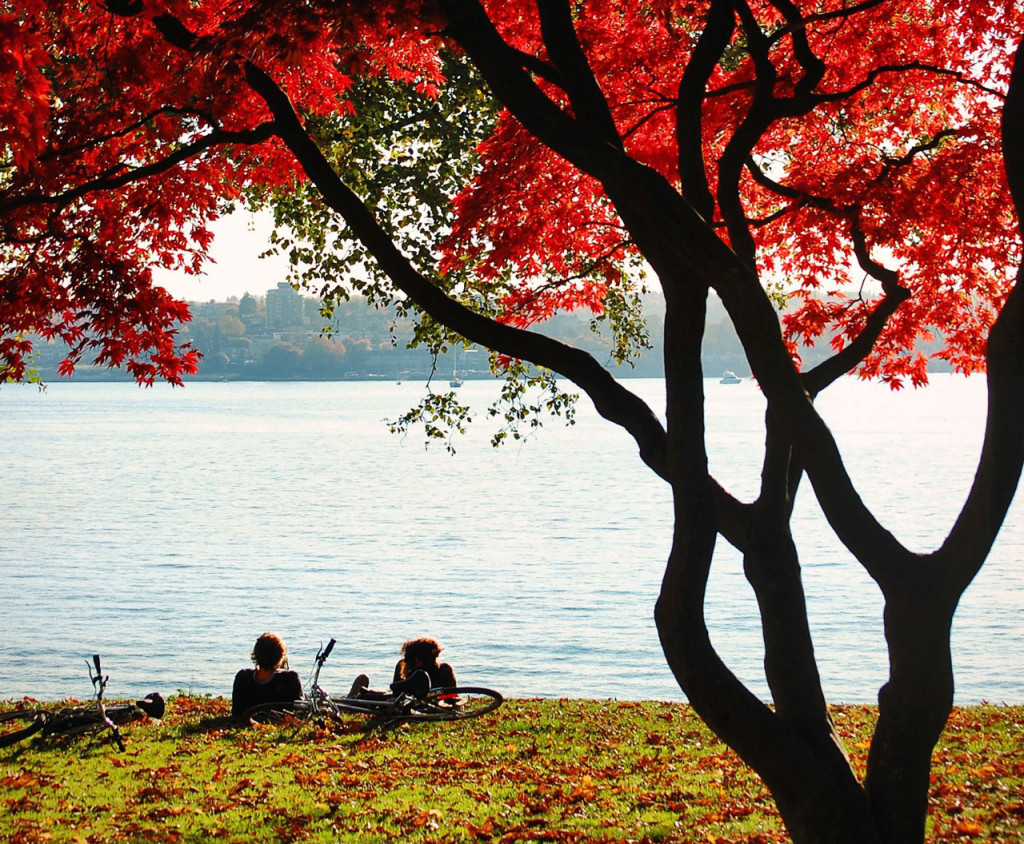
Cyclists rest under a tree in beautiful Stanley Park. Photo © Matt Trapp/123rf.
Dramatic snowcapped mountains rise high above a modern city clinging to the coastline. A downtown core of century-old buildings and steel-and-glass skyscrapers overlook busy waterways. Sandy beaches and rocky shorelines fringe manicured suburbs. Magnificent old-growth forests and brilliant flower gardens overflow with color. And residents in love with the outdoors eagerly take advantage of its magnificent natural surroundings.
It’s hard to believe that just a few decades ago, this valley was an almost-forgotten ski area with a couple of lifts and a smattering of rustic holiday homes. Today the newly upgraded Sea to Sky Highway leads to a hip, outdoorsy resort town of epic proportions. Chairlifts and gondolas span two mountains, opening up more terrain than any other alpine resort in North America.
The elegant capital of British Columbia couldn’t be more different from its much larger neighbor, Vancouver. Well-preserved buildings line the streets. Totem poles sprout from shady parks. Restored historical areas house trendy shops, offices, and exotic restaurants. Meanwhile double-decker buses and horse-drawn carriages compete for the tourist summer trade.
Wherever you travel on this 450-kilometer- long (280-mile) island, the emphasis is on outdoor recreation. A large swath of old-growth forest along the west coast is protected as national park land while local beaches provide surfers with some of Canada’s finest waves. Other experiences range from one of the world’s great long-distance coastal hikes to sea kayaking through a protected archipelago.
High season is from mid-June to early September. Tourist attractions and hotels are busiest during July and August. During the shoulder seasons, May to mid- June and September, crowds thin out and accommodations reduce rates. The rest of the year is the low season: tourist numbers dwindle, attractions shorten their hours, and lodging prices drastically decrease. In the ski town of Whistler the seasons are reversed: winter (December through April) is high season.
My favorite time to visit is during April and May. Days are long and warm enough to enjoy the outdoors, but crowds are at a minimum, and lodging rates are lower. The roses at Butchart Gardens don’t flower until July, but I can live without that.
Vancouver and Victoria can be visited year-round, with some outdoor activities possible in the dead of winter in Victoria, such as golfing, biking, and walking. Winter also brings snow to the mountains, which means skiing and snowboarding at nearby resorts.
To enter Canada, a passport, passport card, or NEXUS card is required by citizens and permanent residents of the United States. For further information, see the website travel.state.gov. For current entry requirements to Canada, check the Citizenship and Immigration Canada website. All other foreign visitors must have a valid passport and may need a visa or visitors permit depending on their country of residence and the vagaries of international politics. Visas are not required for citizens of the United States, the British Commonwealth, or Western Europe. The entry permit is for six months. You may be asked to show onward tickets or proof of sufficient funds for your stay.
Visitors have the option of arriving by road, rail, ferry, or air. The main gateway city for flights is Vancouver. Although Vancouver has an excellent public transit system, including rail service linking the airport to downtown, driving is the best way to get around Vancouver Island.
Excerpted from the First Edition of Moon Vancouver & Victoria.